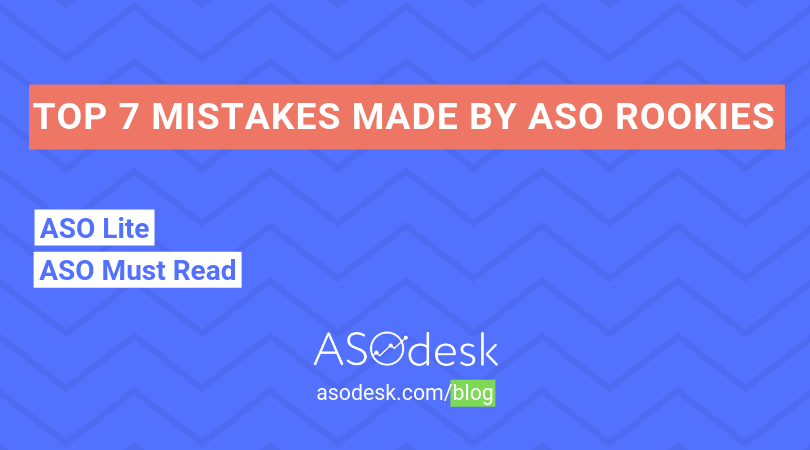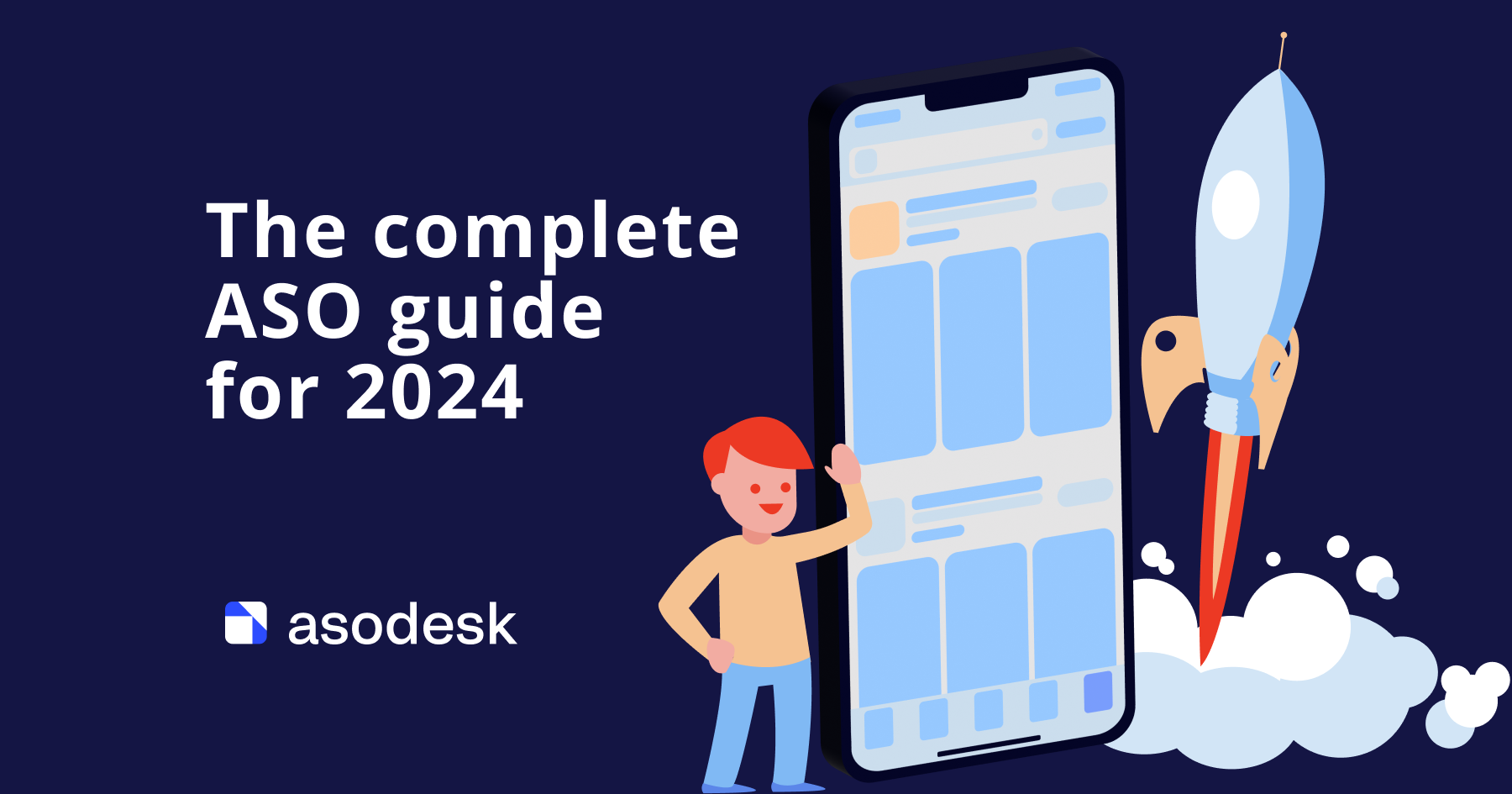Top 7 Mistakes Made by ASO Rookies

At ASOdesk, we believe that ASO (App Store Optimization) isn’t rocket science. For us, ASO is a properly adjusted set of processes on semantic core building, its analysis, and identification of its final hypotheses for the subsequent “in action” check-up.
This article is going to be more valuable for rookies, who just begin working with ASO – it will help them to avoid basic mistakes in the very beginning of their learning.
Mistake #1. Not Studying Your Niche in Terms of Search Traffic
We all remember about Apple’s statement that was uttered during the WWDC 2016, noting that the amount of App Store’s search traffic makes up 65% of the overall volume. The statement was timed to the Apple Search Ads’ launch, although Apple didn’t mention that most of this traffic belongs to existing brands. But, we’ll get back to this later.
Before getting to any business activity, the very first thing you should do is build correct expectations regarding the outcome. Thus, when you are planning to invest in promotion via ASO, you must have a clear understanding about the development of this search area for your application, or in other words – how many users are aware that apps similar to yours can be found through the search, if they exist at all. We’re not speaking about whether your app is needed or if there are users with a problem or need that can your app can fulfill, but rather about whether they understand that an application with such functionality exists.
For example, in 2014, when we have just started, we have had two clients – one was associated with product delivery, the other one was associated with food delivery. When we started studying what we could do in terms of textual ASO, we came to understanding that the amount of queries on this topic is quite low – there were barely two queries per such topics as “food delivery,” “food order,” “product delivery,” and “product order.” And this wasn’t in Russia. It could be explained by the fact that the potential users just didn’t know that there such mobile apps for product and food ordering have already been developed and that they could find them, while people have actually had this need. Or here’s another example: in the beginning of 2016, the world of mobile apps was struck by MSQRD – an application for animated mask creation. Before it appeared there were no such apps and, thus, there were no search queries related to masks. Users just didn’t know that there is such a thing. After such queries have ultimately appeared, people began creating other similar apps that also work with videos as well as with absolutely other effects (Prisma app, for example), and the amount of queries on this topic started to grow.
Besides the fact that users may simply not know yet about an application that could solve their problems or fulfill their needs, there’s also another search feature in application stores.
It can be divided in two points:
1. Amount of search queries is much lower, than in the web search;
2. Brand traffic is prevalent in certain market niches.
Considering the first point, everything is rather simple: application store user looks for application with a particular functionality, such as “taxi order,” “dating for free,” “photo editor,” and on a very rare occasion they may use navigational queries, like “what to do if (…),” “places to visit in (…).” In the end, amount of queries relevant to your application can be below 50 in one country.
The second point is a lot more curious. There are marketing niches, in which the amount of search traffic is just immense, for example, “social networks” and “messengers.” Herewith, a huge part of this traffic is taken by brand-name apps, including Facebook, WhatsApp, Messenger, etc. Users already know these applications – they’ve either learned of them from friends or have been using them in the past, it doesn’t matter. What matters is that this traffic is taken by these apps. In other words, the amount of search queries of common sense, such as “messenger” (referring to Facebook Messenger), “chat,” etc. are scarce due to the traffic amount that generally falls within the “messengers” niche.
All of this only means that when you start doing ASO, investing in it – and your investment could as well be both agency service orders and ASO platform costs, – and paying your employees, the first thing you would have to do is evaluate your niche’s search traffic volume in order to understand, if ASO will provide you with “good” growth or if ASO for you is secondary and it’s much more effective to invest your efforts into other traffic attraction channels, instead of blindly believing Apple’s 65% statement.
Mistake #2. Not Studying Store Suggestions in the Application Store
We have already mentioned that the search for applications in stores differs from web search: along with the number of search queries, it also has another feature. In most cases, a user is rather lazy to introduce the entire search term they are thinking of. It’s much simpler for them to select a suggestion that emerges as they type.

In other words, presence of a query in store suggestions means that there’s traffic for this term. Such query shouldn’t be missed by your semantic core.
Mistake #3. Not Studying Competitors
When we were starting about 4-5 years ago, we could number applications using ASO with fingers on one hand, but right now the chances are high that you already have a competitor that took care of this. This, in turn, means that the semantic core bulding will not take as much time and that no search query will escape your attention.
The more competitors you examine, the lower the probability for you to overlook an interesting search query.

Mistake #4. Using Wrong Data Regarding Search Queries
The main issue that looms over the area of ASO is the lack of reliable official information about the search query frequency in terms of users. The fact that many ASO systems take the search query frequency data from the web is a problem, too. We know that web search is drastically different from application store search. This may lead to not paying attention to search queries that are completely unpopular in app stores, but can fairly well be popular on the web. This means that the provided number of indexed characters is going to be used for zero queries. If you do this, your ASO will be inefficient.
Things available at the moment:
Search Ads Popularity – a logarithmic index from 5 to 100 provided by Apple during Apple Search Ads ad campaign setting up. Its main issue is a small division number. That is, queries with the same index can be substantially different from the frequency on large markets.
Also, Apple Search Ads isn’t available in all countries. You can check the relevant list of countries here.
ASOdesk Traffic Score – our platform’s own index that considers store suggestions as well as Search Ads Popularity during calculation. This is our attempt to express the amount of users that use a search query. It should be viewed as a numeric index that reliably determines zero-query searches and the relation between search queries. That is, if Traffic Score = 0 is true, then we have checked store suggestions as well as Apple Search Ads and many other factors. Also, if one query is more frequent, than another one by Traffic Score, it is true, as well. This solves the Search Ads Popularity problem, since the number of divisions is higher.

Mistake #5. Not Using Additional Localizations in App Store
There’s a notion of additional localizations in App Store. Every country has one main localization and some additional. For example, the main localization in Russia is Russian, while additional are English UK and Ukrainian. For us, this means that the number of indexed fields for your app’s optimization is higher, so you will be able to fit more search queries from your semantic core into it.
For example, you only have 160 characters, if you’re using only the main localization in Russia – Name (30) + Subtitle (30) + Keywords (100). On the other hand, if you’re using additional localizations – English UK and Ukrainian, – you’re going to have 480 characters (160×3).

Mistake #6. Not Doing Regular Iterations
Every marketer’s dream is doing it once and not touching it anymore, because it works perfectly. This is difficult in terms of ASO, so you will have to do the same iteration in order to achieve the perfect effect.
Necessity for iterations:
· You don’t know, where your app is going to emerge in search results. But this is important, because your main goal is to maximize search traffic. If you only found search queries, by which your app is below 20th line, you aren’t getting anything from this, so you should look for other queries;
· You don’t know a reliable search query frequency. Sure, you have Apple Search Ads Popularity and ASOdesk Traffic Score, but you have to check the real frequency on practice nonetheless.
Mistake #7. Overlooking Other Factors, Affecting Your App’s Ranking in Search Results
Your app’s position in search results depends not only on whether you included this query into the indexed meta data, but as well on many other factors, such as the overall amount of app downloads, rating, number of reviews, speed of its installation, glitches and ANR errors (Application Not Responding).
On its own, ASO can’t be the decisive factor in your application’s optimization, if you aren’t working on the improvement of other metrics. It can enhance the effect of your application by working together with other marketing activities and product improvements.
We sincerely hope that this material proved useful to you. ASO for everybody!










